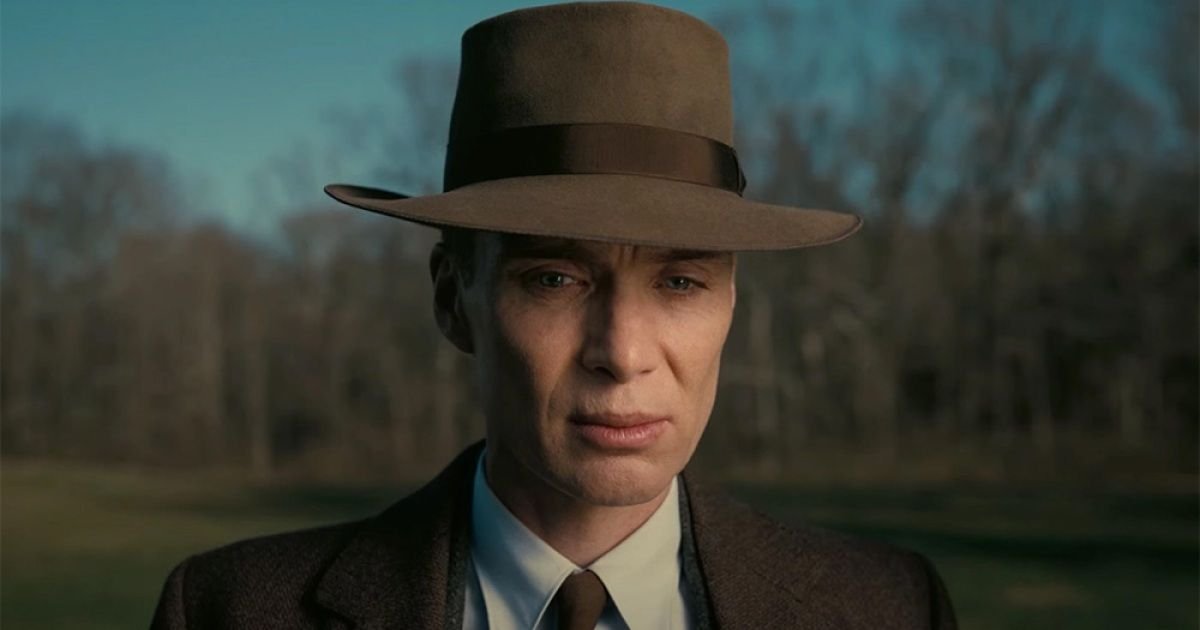Review: Oppenheimer (2023)
With Oppenheimer, Christopher Nolan cements his pre-eminent command of genre forms and narrative innovation among contemporary filmmakers. Nolan’s Dunkirk (2017) provides a useful point of comparison to his latest work. As Dunkirk is a war movie but also very much a Christopher Nolan movie, Oppenheimer is a biographical epic that is also distinctly a film by Nolan. The difference is that the characters in Dunkirk are all but nameless, personifying universal facets of man at war, whereas Oppenheimer is concerned with portraying the individual subjectivity of one man, J. Robert Oppenheimer, the theoretical physicist who led the Los Alamos Laboratory, where the first atomic bombs were invented.
Oppenheimer is a biopic, and it follows many of the conventions of the typical Hollywood approach. The great man must overcome both his doubters and his flaws in order to make his mark on the world. We see how his romances and friendships impact his professional goals. He also has a clear mission: build a bomb before the Nazis build theirs. At the same time, like all his movies, Oppenheimer continues Nolan’s film project exploring narrative innovation and complexity, especially through the use of intercutting, as well as the vitality and possibilities of celluloid film, shot here in 65mm and printed in 70mm and IMAX. With regard to Oppenheimer, Nolan seems to have asked himself: how to tell a story about the “Father of the Atomic Bomb” in a creative way that makes the audience see the man and his invention differently?
Nolan’s first step is to make the story of the man the story of a period and its peoples. Nolan is an admirer of David Lean, and Lean’s masterpiece, Lawrence of Arabia (1962), provides another useful point of reference to this film, showing Nolan how to make a biographical epic that is grand and expansive—both horizontally, in terms of breadth of subject matter, as well as vertically, in terms of depth, exploring the personality, motivations, and behaviour of an important historical figure.
The expansive storytelling of Oppenheimer means that this is not simply a story about the Manhattan Project, as the film’s promotional material largely suggested. I have no doubt that many in the audience will be surprised by how much of the film’s three-hour run time covers periods of Oppenheimer’s life before and especially after the Second World War.
Nolan uses Oppenheimer’s life as a lens to explore a wider narrative about modernity, science, government, war, and philosophical uncertainty, to name only several of the film’s concerns. To do this, Nolan divides his narrative into two main storylines. “Fission” is told in colour and is mostly about the path that leads Oppenheimer to the Manhattan Project and culminates in the “Trinity” test of the first atom bomb. This is the storyline promoted in the film’s trailers and promos. “Fusion” is shot partially in black-and-white and takes place some years later: in 1954, when an older Oppenheimer faces a tribunal set on revoking his security clearance, ostensibly for his growing concerns about the US-Soviet arms race and his Communist associations from earlier in his life; as well as in 1959, during Lewis Strauss’s (Robert Downey Jr.) cabinet nomination confirmation hearings.
To make things even more complex, neither of the two storylines is told in perfectly linear fashion. Instead, there is plenty of intercutting across time and space. Early on, for example, we see Strauss talk about Oppenheimer in 1959 in black and white, as well as questions put directly to Oppenheimer in 1954 in colour. The questions about his time abroad spark a montage showing Oppenheimer’s graduate studies at Cambridge and in Germany and the Netherlands.
Nolan repeatedly teases the significance of a cryptic moment, sometime after the war, when Strauss sees Oppenheimer and Einstein have a conversation beside a pond. Nolan will use that moment to explore paradox: how, through human subjectivity, a moment can hold multiple or even contradictory meanings. But the film’s basic message is clearer: the birth of the bomb birthed a new era, both scientifically and in terms of social and political meaning. More intriguing is the suggestion that we humans cannot anticipate the points of fission and fusion in our lives: where will things in our lives split off and where things come together?
Most of Nolan’s thematic and formal concerns in Oppenheimer do come together to achieve a successful whole, even if a few parts of the complex narrative sag and stretch in ways that only a second or third viewing will clarify for me. For example, using the epic scope, Nolan spends time cultivating Oppenheimer’s many relationships with colleagues, coworkers, friends, family, even antagonists. How much time on each of these relationships is really essential to tell the main storylines? Or how much time do we need to spend with Strauss talking to his aids in a back room in 1959? All of it is interesting, in my view, but does the length spread the film too thin and dilute its impact? After a single viewing, I’m unsure.
I have spent a lot of time discussing Nolan’s narrative complexity, but my emphasis should not overshadow the many and varied achievements of the film. The excellent acting, not only by Cillian Murphy in the lead as Oppenheimer, but also across the wide supporting cast, deserves a lot of praise. Murphy leads what is probably the strongest roster of performances in Nolan’s movies. Nolan and his casting producers have assembled one of the deepest benches for a big movie I have seen in recent years, recalling the great screen epics of the past, with solid actors such as Jason Clarke and Matthew Modine showing up for only a few scenes. I was surprised to see Josh Hartnett return to the screen as a professor. Robert Downey Jr. brings his force of personality to an important supporting character, helping to keep our attention on Strauss when the film shifts away from Murphy’s Oppenheimer. Murphy’s portrayal of Oppenheimer may not have the sheer emotional engagement of Matthew McConaughey in Interstellar, but it’s more complex and nuanced. Murphy’s Oppenheimer is a puzzle, and we see clues and insights but rarely the fully bared man. This might be Murphy’s best performance.
Nolan’s cinematographer, Hoyte Van Hoytema, does some of his best work here, alternating between closed-room black-and-white conversations with close-ups that draw out the characters’ tensions and ticks, to expansive colour vistas of the American Southwest, to starry night skies and the intense oranges of swirling flames. While the camera is often moving, the individual compositions seem more thought-out than in some of Nolan’s earlier films, such as his Batman movies.
Nolan’s aesthetic development arguably culminates in the first twenty or so minutes of the movie, when the montage editing and luminous cinematography, interspersed with haunting images of both the atomic and cosmic levels, and backed by the Ludwig Göransson’s throbbing strings, create a transcendent sequence that recalls the best of Terrence Malick.
At the same time, the classical Hollywood construction of tension for the film’s climax, depicting the Trinity test of the first atom bomb, expertly builds suspense, withholding the explosive sound for what seems like minutes to convey the agonizing breaths of anticipation of the scientists. A scientific test isn’t the kind of explosion that usually goes off during a summer blockbuster, but this is still the cinema of spectacle at its finest.
Some might wonder if certain features, such as Nolan’s greater attention to artful visuals, or the inclusion of nudity, several sex scenes, and an R-rating, are part of a bid for greater awards season acclaim. Does he just really want an Oscar nomination finally? Is he trying to include more of the conventions of “serious” Hollywood filmmaking for his prestige biopic? In my view, these aspects do not feel like crude attempts to attain Oscar acclaim, even if they demonstrate Nolan’s interest in developing and expanding certain aspects of his filmmaking. Nolan is taking the artistic freedom to explore more complex and adult themes here than in his previous, more blockbuster, fare.
Along these lines, the sex scenes are done in ways that create far more meaning than most sex scenes in movies, genuinely advancing the storytelling. One strange moment, which I won’t describe here, contrasts the feelings of comfort and freedom associated with intimate nakedness to the discomfort and shame of public exposure. The scene thus extends the contrasts of intercutting in a way that connects with Nolan’s already established concerns.
In spite of the film’s many formal and thematic strengths, however, I expect there might be some disappointment from those who want more about the mechanics of building a bomb and from those brought in solely by the aggressive blockbuster marketing. This is a three-hour historical epic coming out in the middle of the summer, which is supposed to be popcorn season. Well, it’s already a hit at the box office, but will the audience’s enjoyment persist beyond first weekend curiosity? I think Oppenheimer shows us that there is a hunger for strong storytelling, and not just spectacle, for audiences being treated as if they are intelligent and curious rather than stupid and credulous. But make no mistake, even if this is a story, in many ways, about scientists talking and politicians scheming, this is also a movie that demands to be seen on the closest IMAX, or at least the biggest screen, available.
Like Oppeneheimer’s project, the film joins theory to application with extraordinary success. Perhaps my highest praise for the film would be that, like the great Lawrence of Arabia and its subject, T. E. Lawrence, Oppenheimer looks set to shape the public’s perception of the famous scientist from now on. We will be seeing the Father of the Atomic Bomb through Nolan’s eyes for years to come.
9 out of 10
Oppenhemier (USA/UK, 2023)
Written for the screen and directed by Christopher Nolan, based on the book, American Prometheus, by Kai Bird and Martin J. Sherwin; starring Cillian Murphy, Emily Blunt, Matt Damon, Robert Downey Jr., Florence Pugh, Josh Hartnett, Casey Affleck, Rami Malek, Jason Clarke, Matthew Modine, and Kenneth Branagh.



Chime is Kiyoshi Kurosawa’s fatalistic cinema in its purest form.